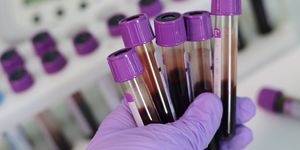A Blood Test Can ID Knee Osteoarthritis Eight Years Before an X-Ray
In osteoarthritis, the tissues that cushion joints begin to degenerate, leading to stiffness, pain, and swelling. According to the World Health Organization, osteoarthritis affects over 500 million people around the world; the knee is the most commonly affected joint, followed by hips and hands. The severity of the disease can vary significantly, but over 344 million people are thought to have moderate or severe cases. More and more people are expected to get osteoarthritis as the world's population ages, and rates of injuries and obesity continue to rise.
The condition is not inevitable as people age, but it does become more likely in older people. Some things that increase the chances of osteoarthritis include a family history of osteoarthritis, repetitive motion, injury, or obesity. There is no way to reverse osteoarthritis, which is often only diagnosed after a joint has suffered structural damage.
New treatments for this condition could benefit millions of people by helping to restore mobility and reduce pain. But scientists and clinicians have to be able to identify early signs of osteoarthritis to learn more about where and when to direct therapeutics.
Researchers have now identified biomarkers that can predict osteoarthritis in the knee as many as eight years before the disease can be detected with an X-ray. The findings have been reported in Science Advances.
"Currently, you've got to have an abnormal X-ray to show clear evidence of knee osteoarthritis, and by the time it shows up on X-ray, your disease has been progressing for some time," explained senior study author Virginia Byers Kraus, MD, PhD, a professor at Duke University School of Medicine. "What our blood test demonstrates is that it's possible to detect this disease much earlier than our current diagnostics permit."
Previous work has shown that this biomarker test can diagnose osteoarthritis in the knee with 85 percent accuracy and predict its progression with 74 percent accuracy. This latest study confirmed and expanded on those findings with samples from 200 women in the UK; half with and half without osteoarthritis. Once again, the biomarkers could distinguish between those with or without the disorder, in some cases eight years before an X-ray diagnosed osteoarthritis in a study participant.
"This is important because it provides more evidence that there are abnormalities in the joint that can be detected by blood biomarkers well before X-rays can detect [osteoarthritis]," Kraus said. "Early-stage osteoarthritis could provide a window of opportunity in which to arrest the disease process and restore joint health."
While more work will be necessary before therapeutics can be applied at the earliest stages of osteoarthritis, this effort is a crucial first step.




















































